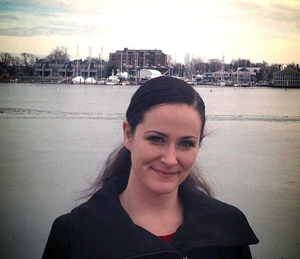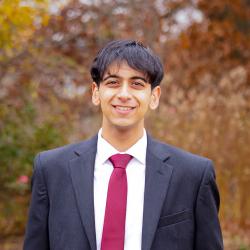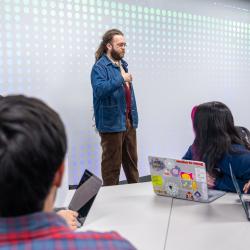Meet Kathryn Mann: A Navy “Shellback” Veteran and a Terp
A senior majoring in computer science, Mann is an ambassador for the Maryland Center for Women in Computing
Kathryn Mann, a senior majoring in computer science, credits the U.S. Navy with helping her find her passion and the University of Maryland for helping her take it to the next level.
 “The Navy assigned me to specialize in cryptography—I didn’t actually have a choice,” said Mann, a computer science major at UMD. “I didn’t even know what cryptography was at the time. I come from a tiny town in Utah. My high school didn’t have computers, just typewriters.”
“The Navy assigned me to specialize in cryptography—I didn’t actually have a choice,” said Mann, a computer science major at UMD. “I didn’t even know what cryptography was at the time. I come from a tiny town in Utah. My high school didn’t have computers, just typewriters.”
Mann fell in love with computers and technology during the seven years she spent in the Navy, where she worked in intelligence and national security.
“I specialized in analysis and reporting, where you have millions of pieces of information coming in and you have to put it together in a way that makes sense to someone else with no technical background,” Mann said. “It’s like doing a puzzle as fast as you can so that you can show it to the captain. It was really fun.”
Mann was primarily stationed at Hawaii’s Pearl Harbor to support U.S. Naval operations in the Pacific Ocean region, which encompasses nearly half of Earth’s surface from Antarctica to the Arctic Circle and from the U.S. West Coast to the Indian Ocean. However, she has fond memories of spending time on ships as well.
“One of the best memories I have was going through my ‘Shellback’ ceremony, which is a Navy tradition that they do the first time that you cross the equator on a ship,” Mann said. “It was a lot of fun, plus I got to swim in the ocean, which you don’t actually get to do a lot of in the Navy.”
Mann left the Navy in 2012 and followed her active-duty husband to Maryland, where he was assigned to the U.S. Navy base in Fort Meade.
“We moved here from Hawaii in February, and we were not prepared,” Mann recalled. “There was snow on the ground and I didn’t have a coat or anything with long sleeves.”
In Maryland, Mann worked as an operations security manager for Farfield Systems, an intelligence and cybersecurity contractor in Catonsville. Although she loved the work, Mann found it difficult to land another position when her contract came to an end.
“I kept hearing, ‘You have the experience but you don’t have a degree,’” Mann said. “So, I started thinking about college. I took some classes at Anne Arundel Community College and then chose to attend the University of Maryland because it’s so highly ranked for computer science. It was a no-brainer.”
Once on campus, Mann discovered that the university supports veterans in many ways. She received priority registration and access to services such as financial aid and counseling through Veteran Student Life. She also met other veterans through TerpVets, a student-run association that hosts social events and provides volunteering opportunities.
“It’s nice to socialize with other vets because I’m older than most of my classmates, so all my jokes are 10 years out of date,” Mann said. “TerpVets also organizes fun events like playing intramural sports against ROTC kids. They tend to win.”
During her sophomore year, Mann received support from another campus organization, the Maryland Center for Women in Computing (MCWIC). The center, which aims to bring more women and other underrepresented minorities into computing, helped Mann overcome a difficult time in her studies and cemented her desire to obtain her degree.
“I started thinking, ‘This is too much work. I don’t see the added benefit. I could be working and getting a paycheck right now,’” Mann said. “But in fall 2016, MCWIC gave me a scholarship to go to the Grace Hopper Celebration, which really made me decide that it was all worth it.”
The annual Grace Hopper Celebration—named after computer science pioneer Rear Admiral Grace Hopper—is the world’s largest gathering of women in computing. Surrounded by so many other women in computer science, Mann aspired to join their ranks and help other women in the field. When she returned to campus, Mann began volunteering with MCWIC.
A MCWIC ambassador since January 2017, Mann teaches classes on programming, cybersecurity, robotics and other computer science topics for middle and high school girls in MCWIC outreach programs such as Computer Science Connect.
“When I was a kid, we did not have technology in our school at all, so now I want to make sure everyone has access to it,” Mann said. “It’s a lot of fun for me to see young women get excited about working with robots or coding their first webpages.”
After she graduates from UMD, Mann plans to pursue a career in cybersecurity, a field she currently works in as a part-time cyber software engineer at Northrup Grumman. She also hopes her story will encourage other veterans to attend a traditional brick-and-mortar university.
“Even though I’m not 18 and I don’t participate in a lot of ‘traditional’ activities like fraternities and sororities, college has been a great experience and I’m glad I came to Maryland,” Mann said. “Besides, making friends with younger students keeps me young.”
###
Media Relations Contact: Irene Ying, 301-405-5204, zying@umd.edu
University of Maryland
College of Computer, Mathematical, and Natural Sciences
2300 Symons Hall
College Park, MD 20742
About the College of Computer, Mathematical, and Natural Sciences
The College of Computer, Mathematical, and Natural Sciences at the University of Maryland educates more than 9,000 future scientific leaders in its undergraduate and graduate programs each year. The college’s 10 departments and more than a dozen interdisciplinary research centers foster scientific discovery with annual sponsored research funding exceeding $175 million.







